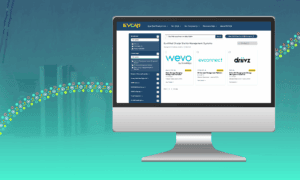Utilities are already feeling the impacts of electric vehicles on the grid, and many have designed managed charging programs to try to control the rising demand. Managed charging programs could potentially save utilities $30 billion over the next 10 years by providing more grid flexibility, according to a new report by ev.energy. But scaling them requires one critical ingredient: EV charging interoperability.
Interoperability ensures that EVs, chargers, network solutions, energy management systems, and utility grid operations can speak the same digital language. Without it, the transition to electric mobility risks becoming fragmented, expensive, and frustrating for charging operators, drivers, and utilities.
Why EV Charging Interoperability Matters
Interoperability not only helps growth but also increases reliability during the scaling of new technologies. In the early 2000’s, switching to another mobile phone network meant we had to throw away the current number, device, and data. But with Mobile Number Portability (MNP) enabling interoperability, we can seamlessly switch between mobile operators on the same device in a day. EV owners face a similar challenge today; can they successfully charge at a charging station whether they have a Ford or a Kia?
For drivers and fleet operators, interoperability means reliability and convenience: charging at any station, using a single payment method, and trusting that the system will work regardless of the vehicle or charger brand.
For utilities, interoperability provides assurance they can easily call on EV charging networks to shift or optimize charging based on local energy conditions. Also referred to as ‘managed charging’, these programs rely on different hardware and software to safely and reliably work together for end-to-end load management across different aggregators, vehicle types, and chargers.
Lack of Standards Can Hinder EV Infrastructure Progress

When EV charging system software and hardware are not standardized, proprietary silos can cause road blocks. Devices or software made by one manufacturer don’t seamlessly communicate and exchange information with those of a competitor. Likewise, charging stations linked by myriad separate and non-interoperable communication networks stymie progress.
Building a connected and secure electric vehicle (EV) charging ecosystem requires digital infrastructure that works together,” states the Joint Office of Energy and Transportation, a collaboration of the US Departments of Energy (DOE) and Transportation (DOT). “From charging stations and vehicles to utility systems and back-end payment systems, there are many different pieces of the charging experience that need to communicate effectively for successful charge.”
For individual EV owners and commercial fleet managers alike, the consequences of this are problematic in several ways, including potential reliability issues and a frustrating driver experience. Lack of interoperability also delays achieving the volume and speed of EV adoption necessary to meet state, local, and business decarbonization goals.
Key Standards Enabling EV Charging Interoperability
While the field of standards and protocols for EV charging interoperability is still evolving, the following are some of the most relevant standards addressing today’s challenges with interoperability across various aspects of the EV ecosystem:
- Open Charge Point Protocol (OCPP) is developed by the Open Charge Alliance, a coalition of companies in several parts of the EV charging industry. OCPP supports interoperability between various EV charging equipment and management systems, regardless of the manufacturer or type of charging station. When products are certified to OCPP, this protects investments in EV charging infrastructure by reducing the risk of vendor lock-in in a rapidly changing market.
- The SunSpec IEEE 2030.5 and OpenADR communication protocols, plus energy data reports using .CSV files and APIs, all enable EV chargers to communicate with distributed energy resource management systems (DERMS), to support scaled deployment of electrified transportation, grid flexibility, and provide utility bill savings.
- Cybersecurity certifications, such as SOC 2 or ANSI/UL 2900-1, ensure that products can communicate safely with one another, without compromising the results or damaging any of the products involved.
- ISO 15118, developed by the International Organization for Standardization (ISO), specifies a universal communication interface between EVs and electric vehicle supply equipment (EVSE – i.e., charging stations) including guidance to allow for a true ‘plug and charge’ experience, smart charge management, and bi-directional EV charging/discharging, covering all manufacturers and communication networks.
- NACS / J3400, a charging connector standard (North American Charging Standard (NACS, now SAE J3400)), addresses physical interoperability. It determines whether a vehicle can physically connect and charge at a station and is the leading industry standard. The industry is undergoing a transition from multiple connector standards to NACS in North America and is laying the foundation for a true ‘plug and charge’ experience for all.
Together, these standards provide the foundation for a more reliable, seamless, and future-proof charging network.
What’s Next for EV Charge Management
Charge management solutions are essential to enabling the next wave of EV charging infrastructure deployment. Interoperability is critical to this equation. It’s top of mind as we at the Electric Vehicle Charging Accessibility Network (EVCAN) proceed with evaluating, qualifying, and listing the software and related hardware that utility EV load management or managed charging programs depend on.
Working with a consortium of key stakeholders (utilities, states, NGOs, and industry), EVCAN aims to build consistency in EV charging solution performance to accelerate the deployment of reliable and connected EV charging. With the right standards in place, utilities can capture billions in savings, drivers can charge with confidence, and society can move faster toward decarbonization.
Footnote
Reference for “safely and reliably work together…” is adapted from the definition for “interoperable” in Doug Black et al., Survey and Gap Prioritization of U.S. Electric Vehicle Charge Management Deployments, LBNL-2001589 (June 2024), https://transportation.lbl.gov/publications/survey-and-gap-prioritization-us
Want to dive deeper? Check out additional EVCAN resources here:
Managed Charging: The Hidden Engine Behind Scalable EV Charging Infrastructure
Our Community: Utilities



